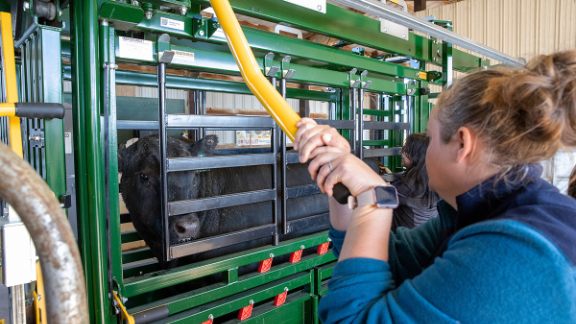by Kim Rendfeld
CARBONDALE, Ill. – Thirty-four bulls have arrived at Southern Illinois University Carbondale to be evaluated over the next several months for desirable growth performance, carcass and genetic traits that can be passed down to offspring.

(Above) Samantha Wuest, program coordinator of University Farms, and SIU zoology major Cecilia Castillo prepare a bull for his stay at the Beef Evaluation Center. (Below) Assistant Professor Jay Nair, School of Agricultural Sciences Director Ira Altman, College of Agricultural, Life, and Physical Sciences Dean Kristina Boone and University Farms Director Christopher Vick celebrate the arrival of this year’s bulls. (Photos by Russell Bailey)
The 44th Annual Bull Performance Test and Sale officially began with the arrival of 17 junior bulls and 17 senior bulls on Oct. 20. Jay Nair, assistant professor in the School of Agricultural Sciences, said that the SIU Beef Evaluation Center (Bull Test Station) is one example of what makes SIU Carbondale rare among Research 1 universities in the Carnegie Classification of Institutions for Higher Education.
“Only a select group of universities in the U.S. can perform this service for the cattle producers — both the consigners who have entrusted us with the bulls and the buyers,” he said.
“At SIU, we are blessed to have the animal units and the bull test station that has served the beef producers of Central and Southern Illinois for more than half a century. Reviving the SIU Bull Test in 2024, following a five-year hiatus, was made possible only through the unwavering support of the University Farms staff.”
When the bulls arrive, students and staff weigh them, attach an RFID tag to the left ear for recording feed intake using the C-Lock SmartFeed units and a station ID tag on the right ear, give them a vaccine against warts, and apply a pour-on parasiticide. Seven-month-old junior bulls typically weigh between 500 and 600 pounds, and they are expected to at least double their weight by the time they are sold in March.
A veterinarian will evaluate the bulls through breeding soundness evaluation to ensure that the bulls are capable enough to sire calves. Senior bulls, which are larger than junior bulls and usually just over a year old, are used for breeding during the summer, while some junior bulls may join the breeding herd during the following fall.
The actual bull test spans over 84 days. The faculty, staff and students at the center will weigh the bulls every 28 days, monitor feed intake, monitor their body condition and skeletal structure and use ultrasound to evaluate back fat, intramuscular fat, and the “ribeye” area (between the 12th and 13th ribs).

Each bull will be featured in a catalog with detailed information for buyers. This year’s breeds include Angus, Simmental and SimAngus.
The test and sale go back to the 1970s. In recent years, SIU has upgraded to an automated feed intake monitoring system that measures how much each bull consumes, thanks to grants from the U.S. Department of Agriculture, and installed a new scale, thanks to the support of School of Agricultural Sciences, College of Agricultural, Life and Physical Sciences, SIU Foundation and University Farms, Nair said.
In addition to being an opportunity for research, the project will help one graduate student and four undergraduate students to learn about all aspects of feeding and management, record keeping, animal health and welfare, sales and services.
Nair’s co-investigators, Karen Jones and Eduardo Gastal, professors in the School of Agricultural Sciences, and SIU Beef Center staff are assisting with the test and sale.
